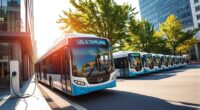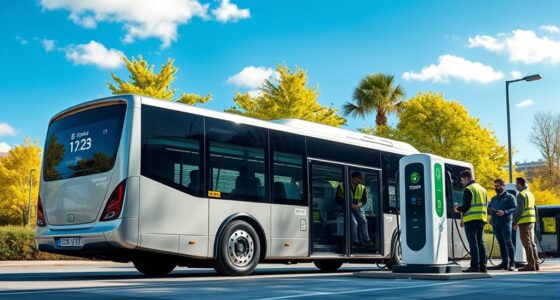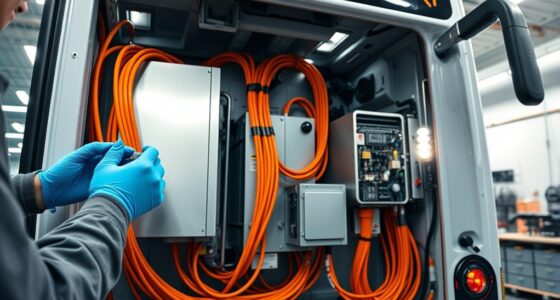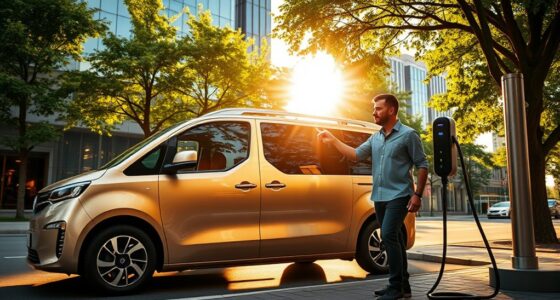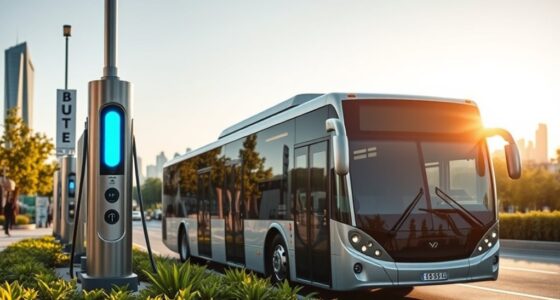To plan long trips with an electric bus, you should understand your battery capacity and set realistic range expectations based on real-world data. Optimize your route by considering terrain, passenger load, and accessory use to improve efficiency. Structure your charging strategy with a mix of fast charging and opportunity charges at stops or depots. Staying informed on tech advances and infrastructure options guarantees smooth operation—keep exploring how to make your journeys more effective.
Key Takeaways
- Collect real-world operational data to develop accurate drive cycles and estimate energy consumption for specific routes.
- Utilize simulation tools and route matching to optimize energy use and determine suitable charging points.
- Incorporate fast and opportunity charging strategies to minimize downtime and extend bus range during long trips.
- Plan charging infrastructure proactively with scalable solutions like high-power chargers and smart grid integration.
- Monitor battery health and schedule charging to ensure reliability and prevent operational delays on extended routes.
Understanding Battery Capacity and Range Expectations
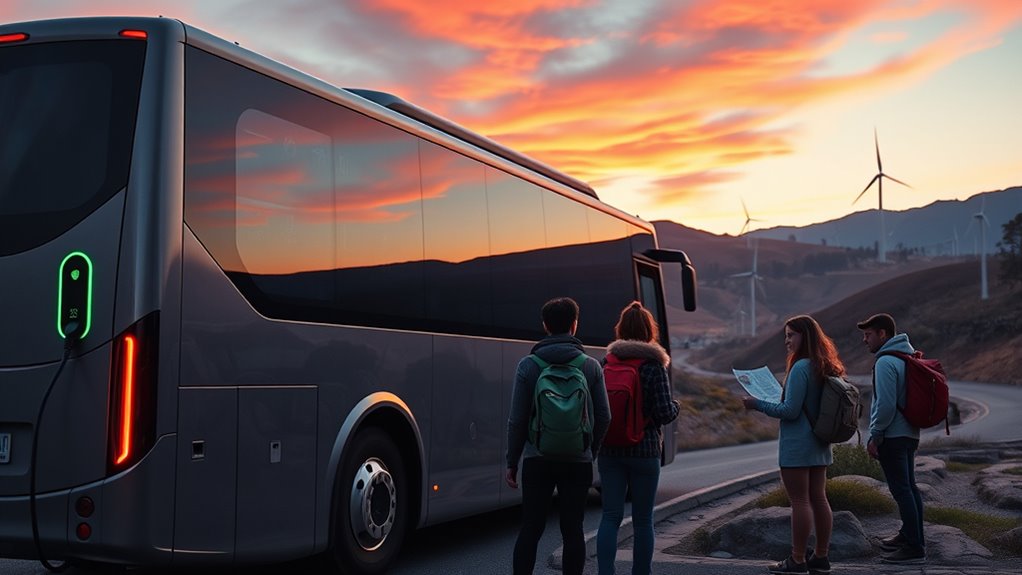
Understanding battery capacity is essential for accurately estimating an electric bus’s range, as larger batteries generally provide longer distances between charges.
Battery capacity is key to accurately estimating an electric bus’s range and performance.
For example, 18-meter buses typically have 350-500+ kWh batteries, with capacity directly affecting their range. A 350 kWh battery can deliver about 190-210 km in real-world conditions without heating.
Keep in mind, only 80-90% of the advertised capacity is usable due to battery health buffers.
Weight also impacts efficiency—lighter buses, like those weighing around 12,850 kg, tend to extend their range compared to heavier models.
Some buses offer over 500 kWh batteries, enabling ranges of 550+ km, especially when combined with performance tuning that optimizes energy use.
Understanding battery configuration and how it influences performance helps you better estimate how far your electric bus can travel before needing a recharge.
Additionally, factors like thermal management systems play a crucial role in maintaining battery health and optimizing range over time.
Optimizing Route Planning for Energy Efficiency
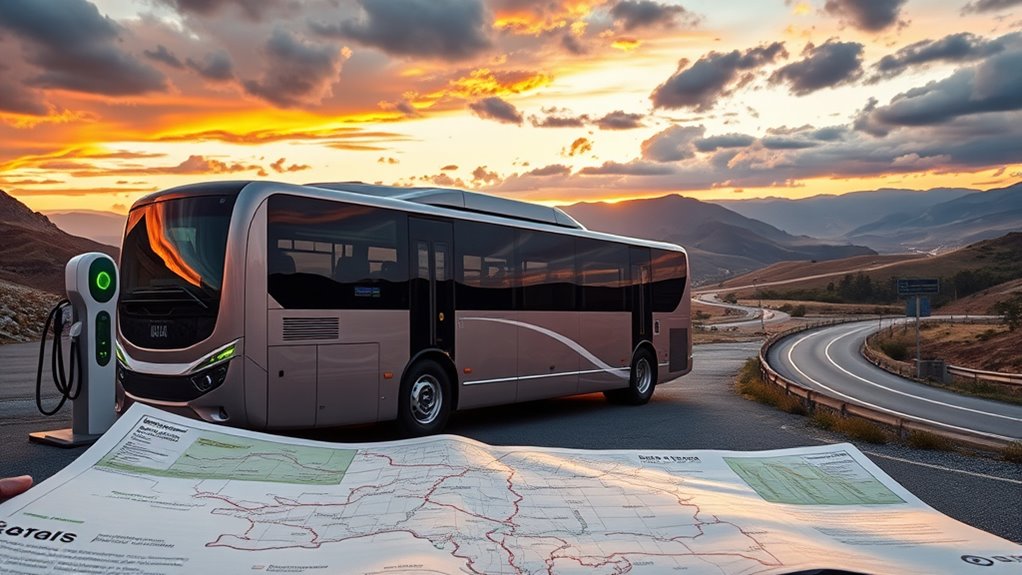
Effective route planning can substantially improve the energy efficiency of your electric bus fleet. By collecting and analyzing real-world operational data, you can develop accurate drive cycles tailored to specific routes. Consider factors like terrain, passenger load, and accessory power to estimate energy consumption precisely. Using simulation software, such as high-fidelity tools from NREL, allows you to model route-specific energy needs and predict driving range. Developing tools for ideal route matching ensures buses operate on routes best suited to their energy profiles, maximizing efficiency. This targeted approach demonstrates significant benefits over traditional diesel buses, reducing energy use and operational costs. Incorporating real-world driving patterns into your planning process can further enhance accuracy and efficiency. Additionally, understanding typical energy consumption rates helps in better estimating charging requirements and scheduling. Recognizing the importance of personality traits can also aid in team coordination and management within fleet operations, leading to smoother execution of your strategies. Implementing these strategies helps you optimize your fleet’s performance, extend vehicle range, and make smarter charging decisions.
Building and Managing Charging Infrastructure
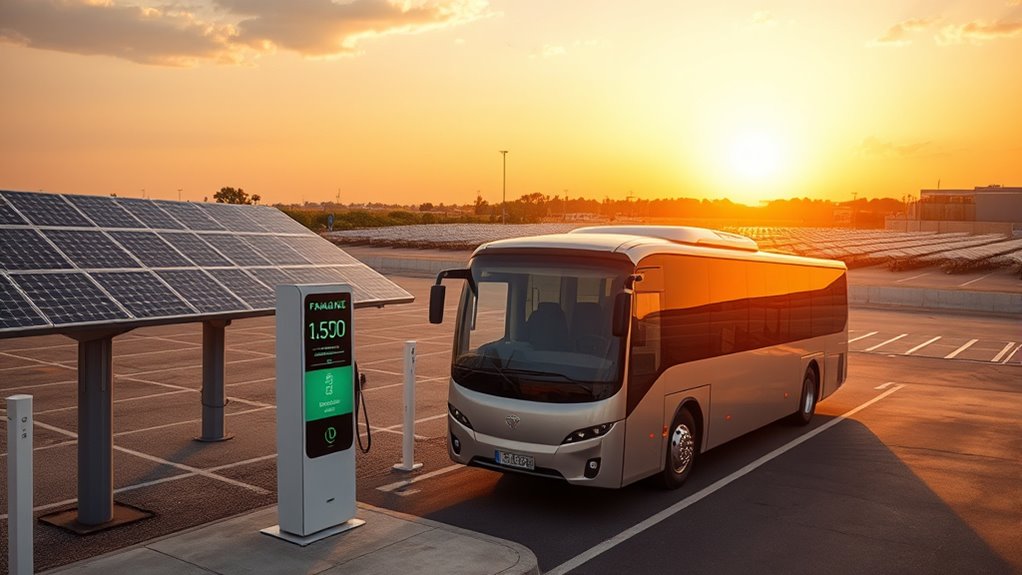
Building and managing charging infrastructure is essential for supporting a reliable and efficient electric bus fleet. You need scalable solutions that can grow with your operations, such as compact satellite units and infrastructure capable of dynamic capacity adjustments. Incorporating innovative charging options can further enhance operational flexibility and efficiency. Choosing the right charging types is key; pantograph systems require overhead structures, while inductive charging offers low maintenance with no moving parts. High-power chargers between 165 and 600 kW enable rapid recharging, but demand careful planning to manage grid load and costs. Efficient cable management and space optimization improve usability, especially in space-constrained areas. Infrastructure expansion should be incremental, allowing you to adapt as your fleet expands. Proper planning guarantees energy efficiency, reduces costs, and supports future technological advancements, ultimately boosting your fleet’s charging infrastructure reliability and sustainability. Additionally, integrating smart grid technologies can optimize energy use and reduce operational expenses.
Leveraging Battery Technology for Long-Distance Travel
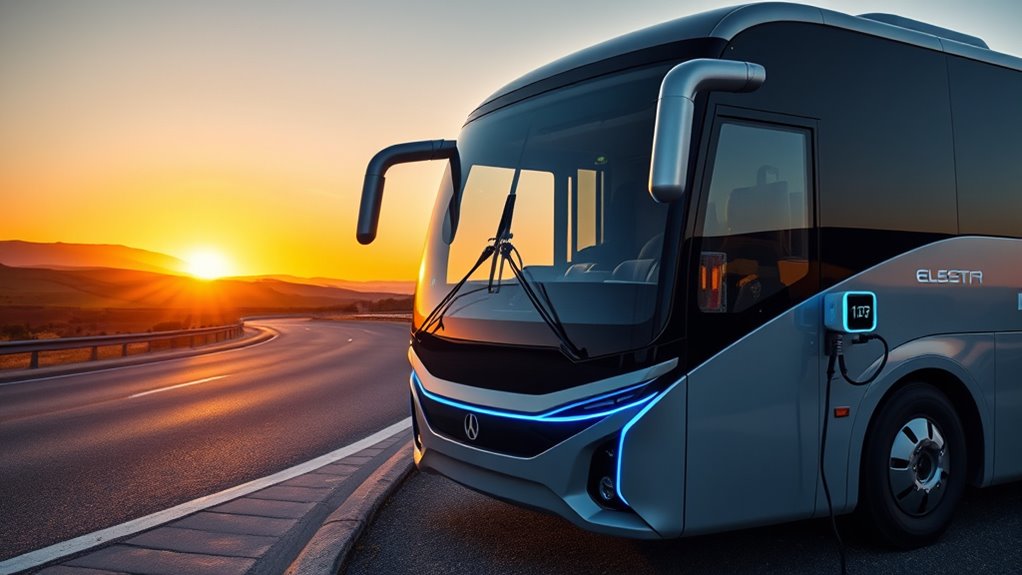
Leveraging advanced battery technology is key to enabling electric buses to cover longer distances without frequent recharging. Lithium-ion batteries are the standard choice, offering high energy density and long lifespan, with capacities ranging from 480 kWh to 640 kWh depending on the bus size. Pimple Patch Improvements in battery design boost energy storage and efficiency, supporting extended routes. Regenerative braking captures energy during deceleration, further increasing range. Future developments, like solid-state batteries, promise even greater efficiency, safety, and range. High-quality batteries can last up to 2 million kilometers, ensuring durability for long journeys. Additionally, performance metrics play a crucial role in monitoring battery health and optimizing charging strategies for maximum longevity. These technological advances are aligned with the renewable energy movement, enhancing sustainability. Proper maintenance and driver techniques can maximize battery performance and extend service life.
Integrating Fast Charging and Opportunity Charging
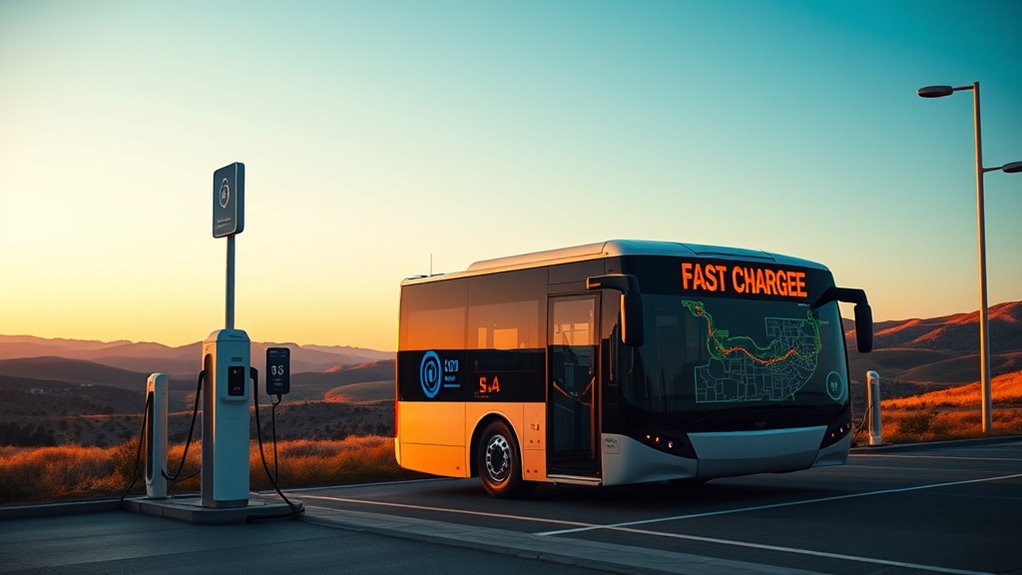
Integrating fast charging and opportunity charging is essential for optimizing electric bus operations and ensuring reliable service. Fast chargers provide quick top-ups at strategic locations, allowing buses to extend routes without long downtimes. Proper placement along routes maximizes efficiency and route flexibility, but infrastructure costs can be high.
Opportunity charging involves short, frequent charging sessions at stops or depots, supporting smaller batteries and reducing vehicle weight. Effective route planning guarantees charging aligns with schedules, minimizing delays.
Combining both strategies offers a balanced approach, optimizing energy use while controlling costs. A well-designed network of fast and opportunity charging points simplifies operational management and enhances service reliability, ensuring buses maintain sufficient charge throughout their journeys.
Proper integration helps achieve operational efficiency and sustainability goals.
Addressing Operational Challenges and Reliability
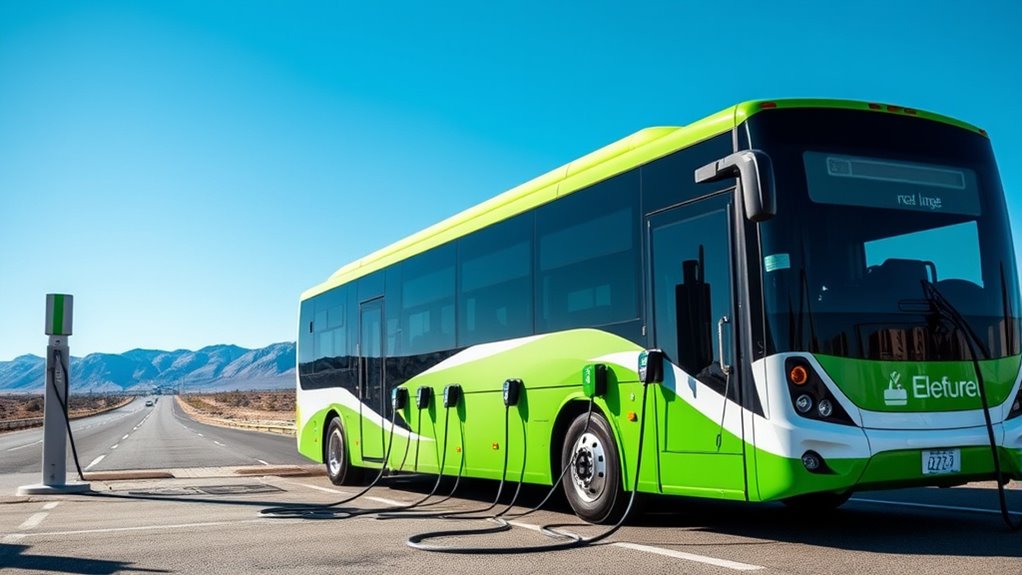
Addressing operational challenges and ensuring reliability are critical steps in successfully deploying electric buses. You must upgrade infrastructure to support large-scale charging, working closely with utilities and electricians from the start. Managing charging schedules is essential to prevent service interruptions and accommodate range limitations. Expect to adjust fleet sizes, as electric buses may need more units to cover routes due to charging downtime. Reliability issues, such as battery and inverter failures, require extensive training for maintenance staff and drivers. Regular scheduled maintenance and quick component replacements help minimize disruptions. Collaborating with manufacturers can resolve technical faults more efficiently. Additionally, understanding ethical hacking techniques can help identify potential security vulnerabilities in charging infrastructure and vehicle systems, enhancing overall safety. Incorporating advanced diagnostics can further streamline maintenance processes and reduce downtime. Staying informed about energy management strategies and implementing smart charging solutions can optimize energy usage and reduce operational costs. By proactively tackling these operational challenges, you improve service availability, safety, and overall dependability of your electric bus fleet.
Exploring Future Trends and Technological Advancements
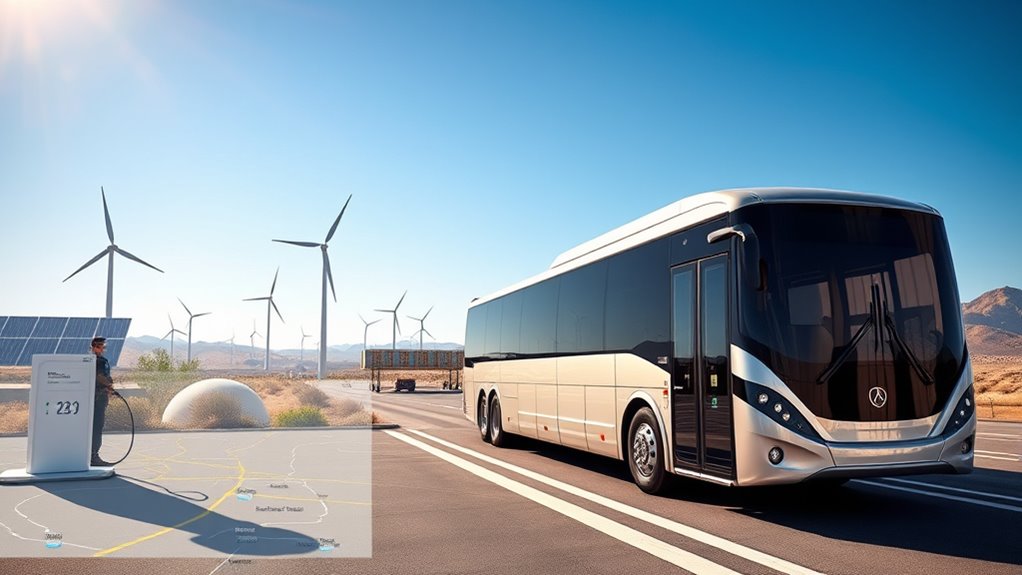
Advancements in battery and motor technologies are driving significant improvements in electric bus performance and efficiency. Solid-state batteries offer higher energy density and safety, enabling longer routes with less weight and size. Fast-charging innovations reduce downtime, making route planning more flexible. Moreover, arcade-style multiplayer options can inspire innovative ways to gamify driver training and safety protocols, enhancing engagement and learning outcomes. Integrating creative problem-solving strategies into technology development can accelerate breakthroughs and optimize system functionalities. Energy-efficient storage systems allow buses to cover more distance between charges. Additionally, thermal management systems are being developed to improve battery longevity and safety under various operational conditions. On the motor side, regenerative braking captures energy during stops, while high-torque motors improve low-speed performance and reduce energy use. Weight-optimized motors maintain efficiency without sacrificing power. Future trends also include smart charging systems and Vehicle-to-Grid (V2G) technology, where buses can help stabilize the grid. Additionally, wireless charging methods are emerging, offering more convenient and seamless recharging options for electric buses. These advancements promise longer ranges, quicker charging, and more sustainable operations, paving the way for wider electric bus adoption and improved urban mobility.
Frequently Asked Questions
How Does Passenger Load Impact Electric Bus Range During Long Trips?
Passenger load slightly impacts your electric bus’s range during long trips. As more passengers board, the bus uses a bit more energy due to added weight.
However, regenerative braking helps recapture some of that energy. While higher loads can reduce your range marginally, smart driving, real-time load monitoring, and efficient route planning help minimize this effect.
Regular maintenance also guarantees your bus operates at its best despite varying passenger numbers.
What Are Best Practices for Scheduling Charging During Multi-Day Routes?
Ever wondered how to keep your electric bus running smoothly across multiple days? You should combine overnight depot charging with opportunity charging at key stops, using fast chargers to top up quickly.
Schedule charging during off-peak hours to save costs, and monitor your energy use with real-time data. These strategies help extend range, reduce downtime, and guarantee your fleet stays ready for the next day’s route.
How Can Weather Conditions Affect Electric Bus Energy Consumption?
Weather conditions markedly impact your electric bus’s energy consumption. Cold temperatures increase energy needed for heating and battery maintenance, reducing range and efficiency.
You’ll notice higher energy use for cabin warmth and battery preconditioning, and charging times may lengthen. To counter this, precondition your bus, locate weatherproof charging stations, and adjust routes for colder days.
Staying aware of seasonal variations helps optimize your bus’s performance and maintain reliable operations.
What Maintenance Considerations Are Unique to High-Capacity Electric Bus Batteries?
Think of your high-capacity electric bus battery as a delicate garden needing careful tending. You must monitor its health regularly, prevent deep discharges, and keep it within ideal temperature and SOC ranges.
Avoid aggressive fast charging, which can accelerate wear, and guarantee proper maintenance routines.
How Do Different Charging Standards Influence Infrastructure Development?
You need to understand how various charging standards shape infrastructure development. Different standards, like CCS, CHAdeMO, or proprietary connectors, determine what chargers are compatible with your buses, influencing site planning and investment.
They also affect the types of chargers you install—Level 2 or DC fast chargers—impacting costs, power needs, and scalability. Ensuring standards are met helps avoid costly retrofits and supports future growth, making your infrastructure more reliable and adaptable.
Conclusion
Planning long trips with an electric bus is doable when you understand your battery’s range, optimize routes, and leverage fast charging. For example, a city transit agency successfully deployed fast chargers along key routes, reducing downtime and increasing coverage. By adopting smart charging strategies and staying informed about technological advancements, you can guarantee reliable, efficient long-distance travel. With careful planning, electric buses can meet your long-trip needs while reducing environmental impact.

